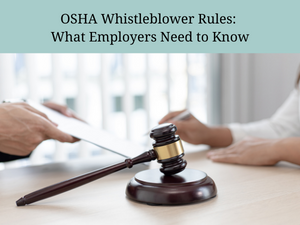If your company is doing something wrong, the law says that your employees have the right to report it. The usual rules about corporate privacy don’t apply when laws are being broken. Whistleblower protection laws contain provisions that make it illegal for an employer to retaliate against an employee for exercising their rights under the law. Retaliation includes adverse employment actions, such as:
- Termination.
- Demotion.
- Blacklisting.
- Disciplining.
- Denying promotion or overtime.
- Intimidation.
- Cutting hours or pay.
- Refusing to hire or rehire.
Whistleblower protection laws enforced by OSHA
The Occupational Safety and Health Administration (OSHA) administers the whistleblower protections of over 20 statutes, including those relating to:
- Health and safety.
- Aviation safety.
- Consumer products.
- Financial reform.
- Health insurance reform.
- Commercial motor carrier safety.
- Securities laws.
- Environmental laws.
- Pipeline safety.
- Nuclear energy production safety.
- Railroad safety.
- Maritime safety.
Statutes administered by OSHA include the Occupational Safety and Health Act, the Affordable Care Act, the Consumer Financial Protection Act of 2010, the Sarbanes-Oxley Act and the Taxpayer First Act. If these laws are broken, any employee may alert the government by filing a complaint or initiating an investigation. The rules are strict and companies ignore them at their peril.
Covered employees have the right to file a retaliation claim
If your employees believe you retaliated against them because they engaged in legally protected activity, they can file a complaint against you. The time frame for filing a complaint with OSHA varies by statute. Some whistleblower protection laws (including the Occupational Safety and Health Act) require employees to file their complaint within 30 days of the alleged violation. Others require 60 days, 90 days or 180 days. Employees can file their complaint orally or in writing, and in any language.
OSHA’s whistleblower investigative process
According to the Department of Labor’s website, “If the allegation is sufficient to proceed with an investigation, the complaint will be assigned to an OSHA whistleblower investigator who is a neutral fact-finder who does not represent either party.”
After the investigation is initiated:
- The investigator will let the complainant (the whistleblower) and the respondent (the company) know that OSHA has launched an investigation.
- The complainant and the respondent should retain any potential evidence surrounding the allegations, such as text messages, emails, letters or voicemails.
- OSHA will ask both parties to give each other a copy of any submissions they delivered to OSHA.
- OSHA will ask the respondent to state their defense (in writing) to the allegation.
Per OSHA, whistleblower investigations vary in length of time. Both parties have the option of settling the dispute at any time during the investigation. Moreover, depending on the statute, the complainant may be able to “kick out,” meaning they can take their case to a federal district court if OSHA does not resolve the dispute by a certain time.
OSHA investigation results
If OSHA does not agree with the employee’s claim of retaliation, the employee can request a review from the Directorate of Whistleblower Protection Programs within 15 days of receiving the dismissal letter. But if OSHA agrees with the employee’s claim, the Secretary of Labor may seek relief for the employee. Relief may include reinstatement, back pay plus interest, punitive damages, and compensation for emotional distress and expenses the employee incurred because of the retaliation.
Companies involved in whistleblower complaints should obtain competent legal advice.
©2021